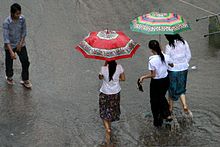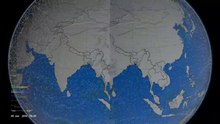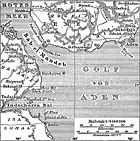Monsoon
![]()
The title of this article is ambiguous. For other meanings, see Monsoon (disambiguation).
The monsoon (from Arabic موسم mausim 'season') is a large-scale air circulation of the lower troposphere in the area of the tropics and subtropics in the sphere of influence of the trade winds. A characteristic of the monsoon are its very directionally stable seasonal monsoon winds in connection with a twofold reversal of the most frequent wind direction in the course of a year.
The monsoon winds are caused both by the migration of the zenith position of the sun between the tropics and by the different warming and cooling properties of different earth surfaces. Since the air over large land masses warms more strongly than the air over the oceans due to the increased solar radiation in the summer half-year, humid air masses move from the sea to the land during this season. This causes a large-scale wind deflection due to the Coriolis force.
The term monsoon has its strongest expression and at the same time its word origin in the area of the Indian Ocean, especially in reference to the Indian, but also to the North Australian and East African monsoon.
The monsoon has a strong influence on the climate of the affected regions due to the high humidity carried by the monsoon wind in summer, which is therefore called the monsoon climate. Characteristic are the long-lasting pronounced summer monsoon rains. The typical vegetation of these regions with summer humid climate is the monsoon forest. The high economic and also cultural-historical importance of the Indian monsoon in particular is derived from this very strong influence on the natural environment.

Monsoon in Cambodia in July

Play media file This animation shows the Asian monsoon as it develops using observational and model data, and some of its effects.
Influence on humans
The importance of monsoons for world nutrition, the supply of drinking water and the irrigation of agricultural soils is of a fundamental nature. More than 60% of the world's population is directly or indirectly affected by monsoon phenomena, especially in India and southern China. The dual character of the monsoon as a guarantor of precipitation on the one hand and, due to its variability (see monsoon rains), also as a cause of droughts and floods on the other, is evident here.
All cultures that developed in the regions affected by monsoon phenomena were and are dependent on the climate. A change in the monsoon is also always associated with a change in the way of life of the people affected by it. This is particularly true of agricultural societies in places where monsoon phenomena develop on a full scale, for example in the Indian region.
Cultural history
The variability of the monsoon, which has always existed and determined the lives of people for millennia, has not only a purely economic significance. The interrelationship between monsoon and man - especially his dependence on the monsoon - entered into culture, art, religion, and even thought and philosophy, again especially in India. This is already evident in the Indus culture, whose dependence on monsoon rains is outlined in the article Indian Monsoon. In addition, the monsoon winds were the carriers of cultural exchange in the Indian Ocean for many centuries, which is discussed in more detail in the following section.
Influence on shipping
In the years 120-117 BC, Eudoxos from Cyzicus undertook an exploratory voyage to India and recognized the importance of the monsoon winds for sailing in the Indian Ocean. Eudoxos then probably passed on his knowledge of the monsoon winds to Hippalus, to whom this discovery in the Periplus of the Erythraean Sea is attributed. Hippalus thus became a legendary navigator and was long thought to be the first to make use of the monsoon winds. The monsoon was therefore formerly called Hippalus in the greater Indic region. However, it is more likely that both Greeks were not the first to take advantage of the monsoon, as Yemenite sailors had been trading in the area long before.
As seafarers, the South Arabs use their knowledge of the monsoon winds in the area of the Indian Ocean and even today, for over two thousand years, they have been cruising with their dhows between the Arab, Indian and African coasts, taking advantage of the changing winds of the monsoon, the Kaskasi and the Kusi, in year-long trading voyages.
In addition to the frankincense trade, Yemen already had close trade contacts with India and East Africa in the 8th century BC. Especially those to Africa were so close that colonies of South Arabian settlers were established in Eritrea. The extensive trade also allowed cultural influences from the Near East to take effect in Yemen. Thus, the South Arabian script was developed from the Phoenician alphabet in the 8th century BC. Since the 3rd century B.C., Hellenistic culture has had a further influence in Yemen, which also entered into indirect trade contacts with the riparian states of the Indian Ocean. This is shown by the cultural artefacts of Hellenistic origin still preserved in this region today.
The cultural exchange of goods and traditions gave rise to the mixed Swahili culture on the East African coast, which was influenced by trade and Islam. The Arabs brought Islam with them to Africa, mixed with the resident Bantu peoples and founded cities such as Lamu, Sofala and Mombasa.
It should therefore be noted that sailing ships using the monsoon wind, together with the great caravans (Silk Road, Incense Road), represented for centuries what was often the only economic and cultural link between the Orient, and thus also the Occident, and the Indian and above all Southeast Asian regions. The monsoon served as a mediator between these cultures, promoted their exchange, and is therefore of central importance in the history of culture and civilization in the Indic region, in addition to its economic significance for maritime trade.
Due to the disappearance of sailing ships and especially due to the "container revolution", the monsoon winds in general no longer play a prominent role in maritime shipping.

Dhow around 1936 in the Gulf of Aden

Historical map of the Gulf of Aden (around 1888)
Etymology
Arab navigators used the word mausim / موسم / 'season' to describe the phenomenon of a wind in the Arabian Sea that changes with the season. Basically, the term monsoon still expresses a change in wind direction between seasons, although it has been subject to change in modern times and with the understanding of the causes of these winds. In the course of this process of knowledge, the scientific understanding of the term has developed from a purely phenomenological wind or season to the totality of the causes, dynamics and effects that condition this phenomenon. To clarify this understanding of the term, one therefore often speaks of a monsoon system or a monsoon circulation. The monsoon thus also represents a climate factor.
Questions and Answers
Q: What is a monsoon?
A: A monsoon is a seasonal wind which lasts for several months, bringing heavy rainfall to certain areas.
Q: Where was the word "monsoon" first used in English for the seasonal rains?
A: The word "monsoon" was first used in English for the seasonal rains in the Indian subcontinent.
Q: What are some other regions where monsoons occur?
A: Monsoons also occur in other regions such as in North America, Sub-Saharan Africa, Brazil, and East Asia.
Q: Why do monsoons happen?
A: Monsoons happen because of a simple fact: land heats up faster than water. The temperature difference between the land and sea creates an area of low pressure, creating a steady wind blowing toward the land, bringing moisture with it.
Q: What is the summer monsoon also known as?
A: The summer monsoon is also known as the southwest monsoon.
Q: How is rainfall increased by monsoons?
A: Rainfall is increased by the moist ocean air being lifted upwards by mountains, as with the Tibetan Plateau, and by surface heating.
Q: How does the hot air over the land tend to rise?
A: The hot air over the land tends to rise, creating an area of low pressure.
Search within the encyclopedia